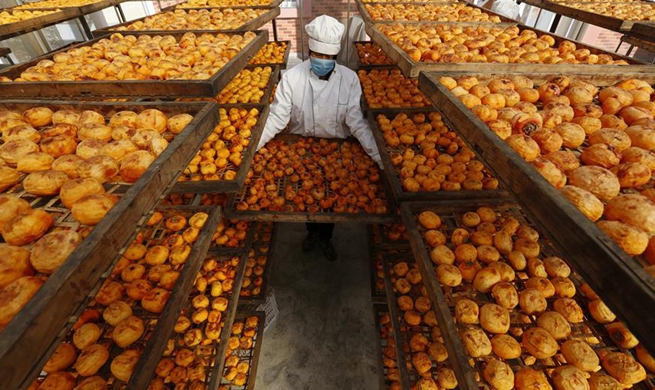by Ejidiah Wangui
NAIROBI, Oct. 30 (Xinhua) -- Jane Mukami was rattled when the skies opened, paving way for torrential rains that threatened to destroy 50 kilograms of rice she had just harvested in her farm in central Kenya.
Having lost her entire harvest in previous heavy downpours, Mukami had to be innovative enough to cushion herself from a similar predicament that not only sapped her energy but also depleted her revenue base.
At the same time, selling her rice immediately after harvesting is not an option for Mukami due to a glut that has affected demand.
To preserve her rice better, Mukami uses clay pots which she first smears with cooking oil before pouring in the cereal -- in this way the rice can stay for longer without being attacked by insects.
After that, she carefully passes a lit candle through the pots in circular motion to kill any insects that may have taken shelter inside.
"It is a tiring process preparing the pots but I don't have any other option. Losing the rice harvest would be more costly to me. In 2015, I lost my entire harvest as the rains hit just after harvesting and I hadn't discovered this technique," Mukami told Xinhua during a recent interview.
Many farmers in Mwea Sub County in central Kenya, where 80 percent of the country's rice is produced, resort to low-cost methods to protect their harvest.
Gregory Kiuna, a potato grower, now uses sawdust to preserve his harvest.
He learned it the hard way and would never want to go through what he experienced three years ago.
"It has taken me two years to get back to my feet after incurring a massive loss. I had just harvested my Irish potatoes, then the skies opened. We didn't get ample time to sort out the produce and potatoes can be highly perishable if not handled well after harvesting," Kiuna said.
Since he started using sawdust to preserve his potatoes, his post-harvest loss has gone down by almost 70 percent.
"The shelf life has gone up from just six weeks to even four months," noted Kiuna.
Post-harvest management has been a major challenge in Kenya's agricultural sector with an estimated loss of 20 percent to 30 percent of harvested crops, or about 500 million U.S. dollars, a year.
According to Denis Otieno, a researcher at Tegemeo Institute of Agricultural Policy and Development, Kenya's post-harvest losses in 2016 accounted for about 48 percent of the production losses -- enough to feed the country for one and a half months.
"Kenya has not been able to meet her annual domestic maize demand since 1994. So if we can manage the post-harvest losses, then the perennial shortage can be addressed to some extent," Otieno told Xinhua.
While Otieno applauds farmers' innovation in handling their harvest, he said there is a need to mechanize the harvesting process.
"Harvesting using machinery reduces harvesting losses since machines harvest and transport the grain to stores, unlike manual process that is associated with high losses to human labor," he said.
The east African region loses 4 percent to 8 percent of grain during harvesting and field drying, 2 percent to 4 percent during transportation to homestead, 1 percent to 2 percent during drying, 1 percent to 3 percent during threshing, 1 percent to 3 percent during winnowing, 2 percent to 5 percent during farm storage, 1 percent to 2 percent during transportation to market, and 2 percent to 4 percent during market storage.
These translate to a cumulative loss of 14 percent to 31 percent, Otieno said.

















